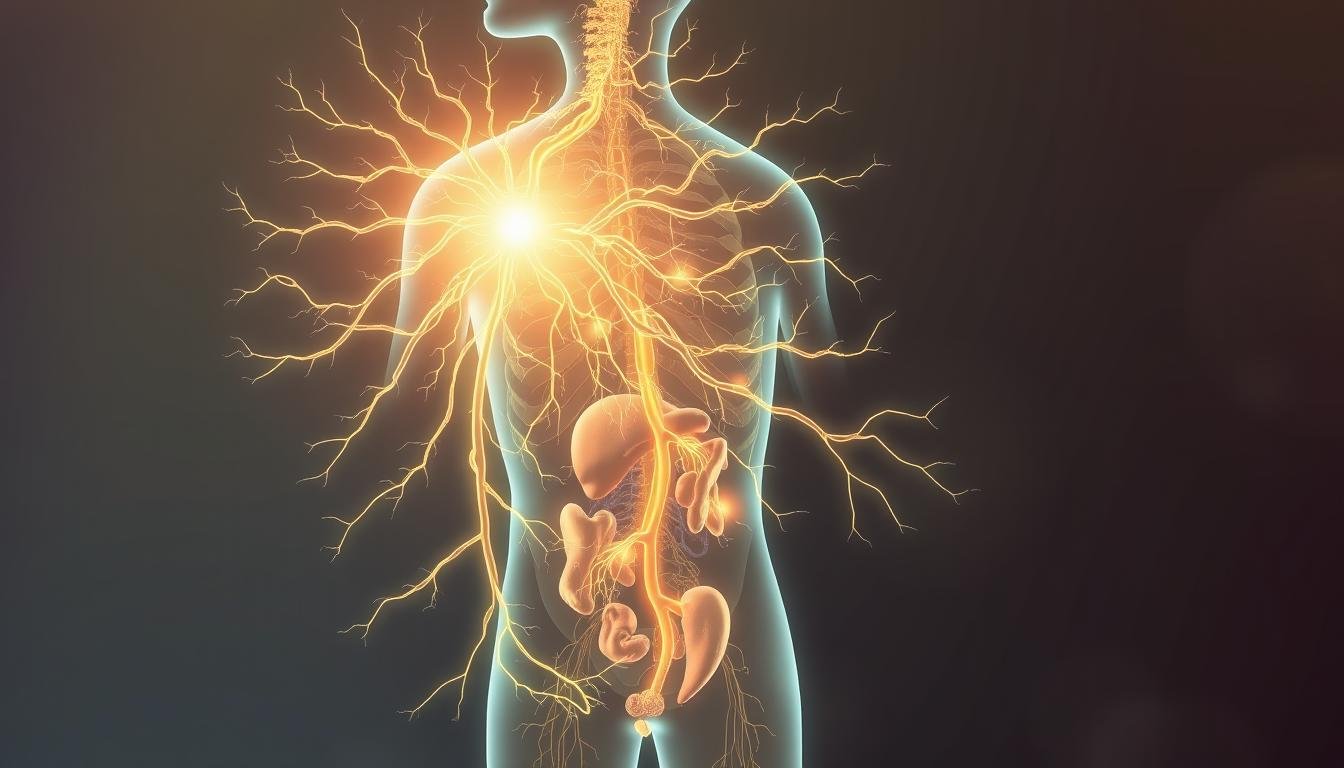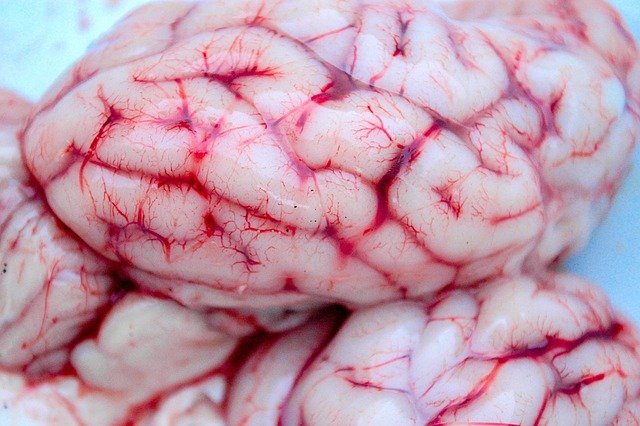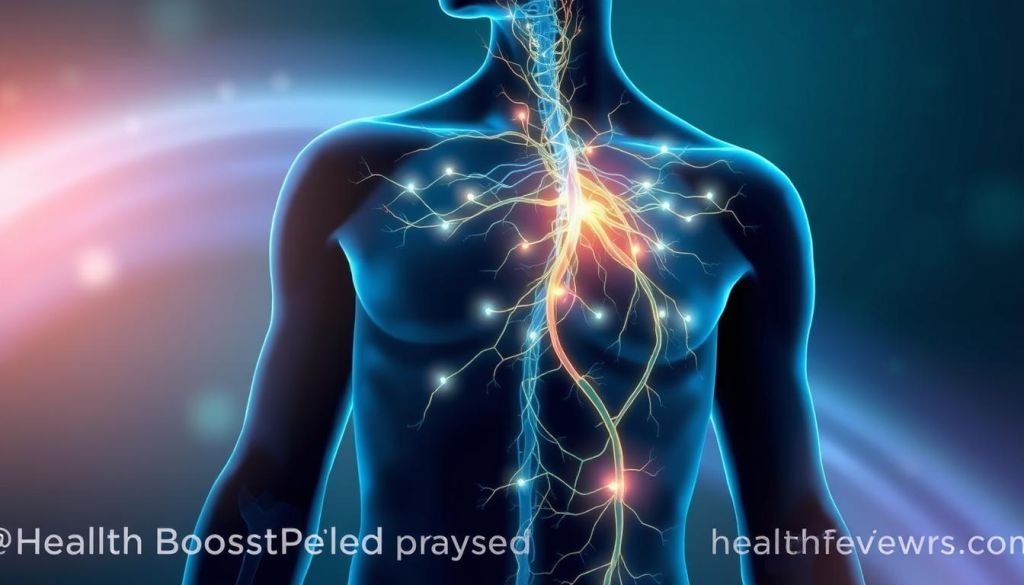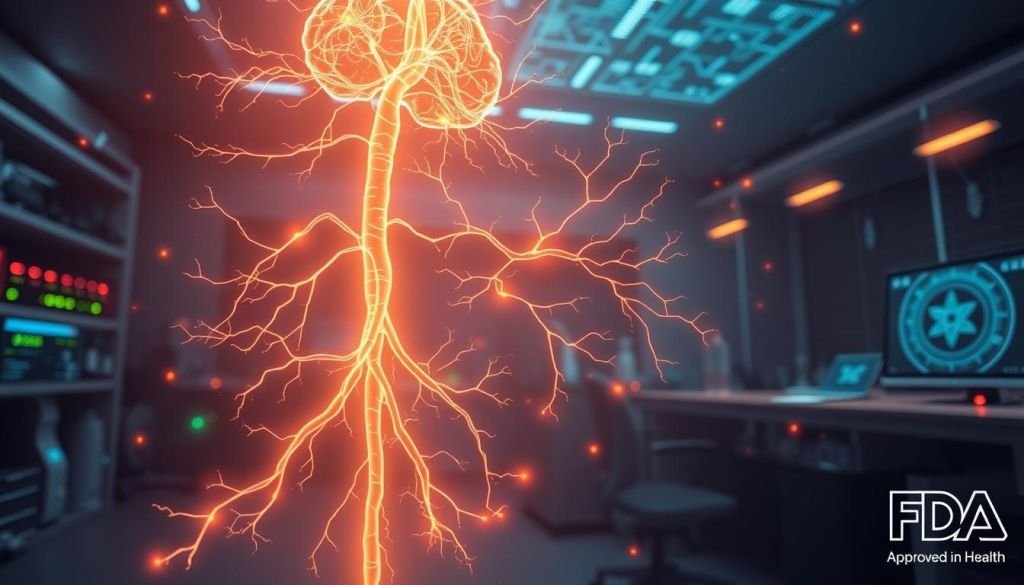
The vagus nerve is a complex network of nerve fibers. It plays a key role in detecting and regulating various bodily functions. Recently, scientists have been studying its healing power and how it can treat different conditions.
The U.S. Food and Drug Administration has approved vagus nerve stimulation (VNS) devices. These are used for treating epilepsy, depression, and stroke recovery. A $250-million NIH initiative called SPARC aims to map the nerve’s fibers and functions. This could lead to new therapies for many conditions.
Key Takeaways
- The vagus nerve, also known as the “wandering nerve,” is the body’s most interconnected nerve, linking the brain to vital organs.
- Researchers are studying the nerve’s healing power and its role in treating neurological and psychiatric conditions.
- The FDA has approved vagus nerve stimulation devices for treating epilepsy, depression, and stroke recovery.
- The SPARC initiative, a $250-million NIH project, aims to map the vagus nerve’s fibers and functions to develop new therapies.
- Advances in understanding the vagus nerve’s role in regulating bodily functions could lead to breakthroughs in neuroscience and medicine.
Understanding the Vagus Nerve: Nature’s Neural Highway
The vagus nerve was named by Thomas Willis in 1664. It’s a key part of our nervous system. It has two nerves, one on each side, with up to 100,000 fibers.
About 80% of these fibers send information from the body to the brain. The other 20% carry instructions from the brain to the body.

Anatomy and Function of the Wandering Nerve
The vagus nerve, also known as the “wandering nerve,” is vital. It controls heart rate, breathing, immunity, digestion, and speech. It helps the body respond to stress, inflammation, and immune system activity.
The Dual Nature of Vagal Pathways
The vagus nerve has a dual role. Its sensory fibers send information from organs to the brain. This lets the brain monitor and respond to the body’s state.
On the other hand, its motor fibers carry instructions from the brain to organs. This enables the body to adjust its functions.
Role in Body System Regulation
The vagus nerve connects the body’s systems. It’s key in the autonomic nervous system, which controls involuntary functions. It helps keep the body in balance and supports overall health.
“The vagus nerve is like nature’s neural highway, connecting the brain to the body’s vital organs and systems. Its dual nature allows for a dynamic interplay between the brain and the body, enabling the regulation of essential functions for overall health and well-being.” – Dr. Sarah Wilson, Neuroscientist
Research on the vagus nerve is growing. It’s showing promise in neuroplasticity, brain rewiring, and neural regeneration. Scientists and clinicians are excited about its possibilities.
The Healing Power of the Brain’s Most Interconnected Nerve Excites Researchers
The vagus nerve, known as the “wandering nerve,” has caught the eye of scientists globally. It’s the most connected nerve in our bodies and plays a key role in controlling inflammation. This nerve links to brain areas linked to mental health issues, making it a promising area for treatment.
In 1997, the U.S. FDA approved a vagus nerve stimulation (VNS) device for epilepsy that didn’t respond to drugs. A similar device was approved in 2005 for depression and in 2021 for stroke recovery. The National Institutes of Health Common Fund started a $250 million SPARC program in 2015 to map the vagus nerve’s fibers and circuits.
Today, clinical trials are testing transcutaneous VNS (tVNS) devices for conditions like rheumatoid arthritis and chronic fatigue syndrome. A study on VNS for epilepsy showed a 45% drop in seizures after a year. Also, 30% of patients with depression saw symptom relief after a year of treatment. But, the cost of VNS treatment in the U.S., around $30,000, is a barrier for many.
The vagus nerve’s role in brain repair mechanisms and neurodegenerative disease treatments fascinates scientists. They are studying how it regulates bodily functions and its link to mental health. As researchers learn more, new treatments may emerge, bringing hope to those with neurological and inflammatory conditions.
| Year | FDA Approval | Condition Treated | Outcomes |
|---|---|---|---|
| 1997 | VNS device | Epilepsy | 45% reduction in seizure frequency after 1 year |
| 2005 | Similar VNS device | Treatment-resistant depression | 30% of patients experienced alleviation of symptoms after 1 year |
| 2021 | VNS device | Stroke recovery | Accelerated stroke recovery |
“The vagus nerve’s role in brain repair and neurodegenerative disease treatments excites researchers. They are studying its function in regulating bodily functions and its link to mental health.”
Breakthrough Discoveries in Neural Regeneration Research
Recent research has uncovered the vital role of mitochondria in fixing nerve cells. It shows that a lack of energy in damaged nerve cells might slow down their healing. This breakthrough could lead to big steps forward in fixing the brain and nerves.
Mitochondrial Role in Nerve Healing
Scientists found that a protein called syntaphilin is key for nerve cell repair. Without this protein, mice with spinal cord injuries healed faster. This means keeping mitochondria working well in damaged neurons is important for fixing nerves.
Energy Crisis in Injured Nerves
The research shows that nerves struggle to heal because they lack energy. Damaged nerves can’t make enough ATP, the body’s energy source, to repair themselves. Finding ways to solve this energy problem could help in healing nerves.
Syntaphilin Protein Impact
Studies on mice without syntaphilin showed great promise. Without syntaphilin, mitochondria move better in damaged nerves, helping them heal. This could mean new ways to help the brain fix nerves naturally.
“These findings highlight the critical role of mitochondrial function in nerve cell regeneration and point to new therapeutic targets for promoting neural repair.”
Vagus Nerve Stimulation: A Revolutionary Treatment Approach
Vagus nerve stimulation (VNS) is a new way to treat many health issues. It helps with epilepsy, depression, and stroke recovery. This therapy has been studied for over a century. But, it became effective for humans and animals in the mid-1980s.
The FDA has approved VNS for treating epilepsy, depression, and stroke recovery. These devices can be implanted or used outside the body. They send out electrical signals that doctors control.
VNS has shown great promise. It can cut down seizure frequency by 45% after a year. It also helps improve mood, making it useful for depression. Scientists are looking into using VNS for other conditions, like inflammatory diseases and long COVID.
The risks of VNS surgery are low. Wound infections are rare (less than 3%) and treated with antibiotics. But, there’s a small chance of a serious problem during the first test, called temporary asystole. Luckily, no deaths have been reported. The most common side effect is hoarseness.
As we learn more about the vagus nerve, VNS’s benefits will likely grow. It could lead to major breakthroughs in treating neurodegenerative diseases and other conditions.

“The vagus nerve is a remarkable structure, and its healing and neural function restoration are just starting to be explored. VNS is a groundbreaking approach with huge promise for future neurodegenerative disease treatments.”
The Role of Mitochondria in Nerve Cell Recovery
Mitochondria are key to our cells’ power. They play a big role in fixing nerve cells after injuries. When they’re damaged, they can’t make enough ATP, the cell’s energy.
This energy problem stops nerve fibers from growing back. It also slows down the brain’s ability to change and heal itself.
ATP Production and Neural Healing
Mitochondria make most of the ATP in nerve cells. After a spinal cord injury, they can’t make enough energy. This makes it hard for the brain to fix itself.
Energy Requirements for Axon Regeneration
Fixing nerve fibers needs a lot of energy. Axons, the long parts of nerve cells, need ATP to move important stuff along them. Without enough energy, they can’t grow back and connect properly.
Scientists are now looking into how to help mitochondria work better. They want to boost energy production to help the brain heal and change more easily.
“Mitochondria are the key to unlocking the brain’s self-repair and regeneration. By understanding their role in energy production, we can develop innovative therapies to support nerve cell recovery.”
Clinical Applications and FDA Approvals
Vagus nerve stimulation (VNS) is gaining attention as a treatment option. In 1997, the FDA approved a VNS device for epilepsy. This was a big step forward for those with drug-resistant seizures.
In 2005, the FDA approved VNS for treatment-resistant depression. This gave hope to those with severe depression. Recently, in 2021, a VNS device was approved to help stroke recovery. This shows how versatile VNS can be.
The FDA has also approved external VNS devices for various conditions. These include obesity, chronic pain, and migraines. These approvals have opened up new possibilities for treating different health issues.
These milestones have been key in advancing neurodegenerative disease treatments. They have also encouraged more research into VNS. As we learn more about the vagus nerve, VNS could help with even more conditions.
| Year | FDA Approval | Condition Treated |
|---|---|---|
| 1997 | VNS Device | Epilepsy |
| 2005 | VNS Device | Treatment-Resistant Depression |
| 2021 | VNS Device | Stroke Recovery |
| Multiple | External VNS Devices | Obesity, Chronic Pain, Migraines |
The growing number of FDA approvals for VNS devices is a big deal. It shows the huge promise of this innovative treatment. As research continues, the future of VNS looks very promising.

Inflammation Control and Neural Healing Mechanisms
The vagus nerve, known as the “wandering nerve,” is key in controlling body inflammation. Studies show it can stop inflammation with electrical impulses, without drugs. This could help treat many chronic conditions, from heart disease to brain disorders.
Cytokine Response in Nerve Regeneration
The vagus nerve can spot inflammation and tell the brain. The brain then sends signals to calm inflammation. This back-and-forth talk between the nervous and immune systems is vital for fixing damaged nerves and brains.
Cytokines, or immune signals, are important in this healing process. When nerves get hurt, cytokines start inflammation. But, they also help heal. Scientists are studying how cytokines and the vagus nerve work together to fix nerves and brains.
Anti-inflammatory Pathways
The vagus nerve’s power to control inflammation is big news for treating many diseases. By stimulating it, researchers can turn on the body’s own anti-inflammatory paths. This means less need for harmful drugs.
This method looks promising for easing symptoms of obesity, metabolic issues, and brain diseases. By focusing on the connection between nerves and the immune system, scientists are finding new ways to fix brains and nerves.
As we learn more about the vagus nerve’s role in fighting inflammation, new treatments are on the horizon. The future of fixing damaged nerves and brains looks bright. It holds hope for better health and happiness for all.
Future Therapeutic Possibilities in Neurodegenerative Treatment
The vagus nerve’s role in healing is changing how we treat neurodegenerative disease treatments. Scientists are looking into ways to boost energy in nerve cells for neural regeneration. This could help with more than just spinal cord injuries, like Alzheimer’s, Parkinson’s, and ALS too.
Nanoparticle-based therapeutics are showing promise. These tiny, targeted particles can get past the blood-brain barrier. This means they can deliver treatments right to the brain. Gene therapy, optogenetics, stem cell therapy, and neuromodulation are also being explored for neurological disease management.
Understanding the causes of neurodegenerative disorders is key. Research focuses on neuroinflammation and how glial cells work. Scientists aim to develop therapies that can control the immune response and support neurons.
New treatments might use vagus nerve stimulation along with other methods. As we learn more about the nervous system, mitochondria, and the immune system, new neurodegenerative disease treatments are on the horizon.
“The vagus nerve’s role in healing and regeneration is a game-changer for treating neurodegenerative conditions. By harnessing this powerful neural pathway, we can unlock new avenues for restoring function and improving the quality of life for those affected by these debilitating diseases.”
Creatine and Neural Energy Enhancement Studies
Scientists are looking into creatine, a natural substance, to boost brain energy and help repair brain cells. Studies on mice show great promise. They suggest creatine could help fix brain damage and grow new brain cells.
Mice on a creatine diet showed better brain recovery after spinal cord injuries. Creatine can enter the brain and increase energy in brain cells. This is key for cell health.
While the results are small, they are hopeful. They show that more energy could help fix damaged brain cells. This is a new way to help the brain heal without surgery.
| Nutrient | Function | Potential Benefits |
|---|---|---|
| Creatine | Boosts mitochondrial energy production | Promotes brain repair mechanisms, supports axonal regrowth, improves functional recovery after nerve injury |
More research is needed to understand how creatine and other nutrients help the brain heal. But, it’s a promising area for finding new treatments for brain damage.
Conclusion: The Future of Neural Regeneration Research
The field of neural regeneration research is growing fast. The vagus nerve and how mitochondria work are key areas. We’ve made big steps in understanding how the brain fixes itself and the vagus nerve’s role.
But, we face challenges in turning this knowledge into treatments for people with neurodegenerative diseases.
Future studies will aim to create better ways to boost energy in the brain and improve vagus nerve stimulation. These advances could greatly help those with spinal cord injuries, Alzheimer’s, Parkinson’s, and other brain conditions. It’s a big hope for millions of people around the world.
As scientists keep studying neural regeneration, we’re getting closer to new therapies. This could greatly improve life for those with serious brain disorders. With hard work and new ideas, the future of neural regeneration research looks bright. It could change the lives of many people in need.






